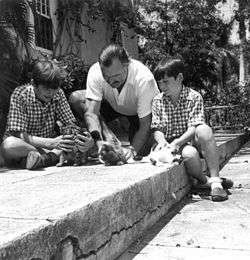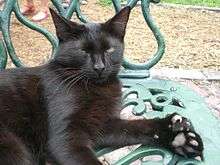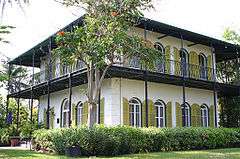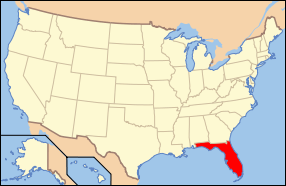Ernest Hemingway House
|
Ernest Hemingway House | |
|
Hemingway House in Key West, Florida | |
| Location |
907 Whitehead Street Key West, Florida |
|---|---|
| Coordinates | 24°33′4″N 81°48′3″W / 24.55111°N 81.80083°WCoordinates: 24°33′4″N 81°48′3″W / 24.55111°N 81.80083°W |
| Built | 1851[1] |
| NRHP Reference # | 68000023 |
| Significant dates | |
| Added to NRHP | November 24, 1968[2] |
| Designated NHL | November 24, 1968[3] |
The Ernest Hemingway House, officially known as the Ernest Hemingway Home & Museum, was the residence of author Ernest Hemingway in Key West, Florida, United States. It is located at 907 Whitehead Street, across from the Key West lighthouse, close to the Southern coast of the island. On November 24, 1968, it was designated a U.S. National Historic Landmark.
History

This was Hemingway's home from 1931 to 1939, although he retained title to the home until he died.[1] It is a private, for-profit landmark and tourist attraction now populated by six- and seven-toed cats that are descendants of Hemingway's cats. The author's second son, Patrick, who lived in the house, stated in a 1994 interview in the Miami Herald's "Tropic" that his father had peacocks in Key West and that he owned cats in Cuba. However, a photo on display at the Hemingway Home in Key West shows Patrick and his younger brother, Gregory, in front of the Cuban water jar near the swimming pool, and Gregory is holding a white cat named Snow White. In addition to the photo showing Patrick and Gregory with Snow White, Hemingway's wife, Pauline, wrote the following in a January 22, 1937, letter to Hemingway (who was staying at the Barclay's Hotel in New York City): "Snow White has become his (G's) fox fur that walks. Esther is having the same old cat looing troubles, with discussed alternatives of 1) getting little female, 2) letting him out and NOT worrying, which turns into letting him out and worrying, 3) castrating, 4) putting ad in paper asking for return of brown, blue-eyed cat with reward."
Descendants of Hemingway's original cats continue to live on the premises. In 2009, the cats became the subject of federal litigation after a museum visitor expressed concern about the cats' welfare. United States Department of Agriculture investigators visited the museum and subsequently ordered the museum to take measures to tag the cats for identification and to shelter them. The museum fought the regulations in court but lost their case in the court of appeals, which ruled that the cats "substantially affect" interstate commerce and thus are protected by the Animal Welfare Act of 1966.[4] The house does not sell cats but does continue a selective breeding program for them.
It was in this house that Hemingway did some of his best work, including the short story classics "The Snows of Kilimanjaro" and "The Short Happy Life of Francis Macomber," his novel To Have And Have Not, and the non-fiction work Green Hills of Africa.
The house stands at an elevation of 16 feet (4.9 m) above sea level but is still the second-highest site on the island. It was originally built in 1851 by Asa Tift, a marine architect and salvage wrecker, in a French Colonial estate style,[5] out of limestone quarried from the site. As testament to its construction and location, it survived many hurricanes, and the deep basement remained, and still remains, dry.[6]
The Hemingways had spent the previous three years living in Key West but had rented housing, the last being a two-story home at 1301 Whitehead Street.[7][8] Pauline (the writer's second wife) found the Tift house for sale at a tax auction in 1931. Pauline's Uncle Gus bought it for her and Ernest, for $8,000 cash, and presented it to them as a wedding gift.[9]
Features
The house was one of the first on the island to be fitted with indoor plumbing and the first on the island to have an upstairs bathroom with running water, fed from a rain cistern on the roof. Also notable are a built-in fireplace and the first swimming pool in Key West, which was the only pool within 100 miles (160 km) in the late 30s. In November 1936, in an interview with the Key West Citizen, Hemingway showed the reporter the location he had planned for a pool. It was Pauline Hemingway, though, who spent $20,000 (equivalent in 2013 to $330,000) to have the deep well-fed pool built for her husband while he was away as a Spanish Civil War correspondent in 1938. When Hemingway returned, he was unpleasantly surprised by the cost and exclaimed, "Well, you might as well have my last cent." This penny is embedded in concrete today near the pool.[7]
In 1937, when Ernest was in Spain, Pauline hired Ernest's friend, driver, and handyman, Toby Bruce, to build the high brick wall that surrounds the house today.[10]
Another of Hemingway's loves was boxing. He set up a ring in his yard and paid local fighters to box with him. He also refereed matches at Blue Heaven, then a saloon but now a restaurant, at 769 Thomas Street.
Hemingway converted a urinal obtained after a renovation at Sloppy Joe's bar into a water fountain in the yard, where it remains a prominent feature at the home, filled with water from the large Cuban jar and serving as one of many water sources for the grounds' cats.[1]
The grounds of the house are maintained as a garden, with many tropical plants installed after Hemingway moved to Cuba. In Hemingway's time, the grounds, like the island, were sparse and dry due to lack of water that only came later, with the Navy's installation of a water line from mainland.
The house was originally purchased for $8,000. After Hemingway's death in 1961, the house was sold by his widow, Mary, to Mrs. Bernice Dickson, the founder of the museum. A prominent feature of the dining room is a Murano glass chandelier. Upstairs, a book display shows books owned by Hemingway while he lived in Key West—including Red Pete the Ruthless by C.M. Bennett. Clearly visible is the inscription, "Given to Hemingway—1936," from Sister Ida, a nun at the local St. Joseph's convent. His writer's studio in the second floor of a free-standing carriage house, and where he stayed briefly (in the 1950s) when visiting from his home in Cuba, was once connected by a second story walkway to the master bedroom. The walkway, shown in pictures from archives, has not been reconstructed.
A garage on the property, with a caretaker's apartment on the second floor, was built to house Ernest's Buick automobile.
In 1988, the house was a filming location of the 16th James Bond movie Licence to Kill. In the scene, Bond resigns from the secret service and then flees through the garden. In protection of M, the fictional guards watch from the Key West Light across the street.
Gallery
 Front of the house
Front of the house A courtyard area
A courtyard area Porch on the side including one of the dozens of cats
Porch on the side including one of the dozens of cats Garden
Garden View from inside the house, showing wheelchair access
View from inside the house, showing wheelchair access View from inside the house
View from inside the house Hemingway's writing desk
Hemingway's writing desk One of the many Polydactyl cats that lives on the property
One of the many Polydactyl cats that lives on the property
References
- 1 2 3 "The House". The Ernest Hemingway Home and Museum. Retrieved 2007-02-12.
- ↑ "National Register of Historical Places – Florida (FL), Monroe County". National Register of Historic Places. National Park Service. 2007-02-12.
- ↑ "Hemingway, Ernest, House". National Historic Landmarks Program. Retrieved 2008-09-18.
- ↑ Richey, Warren (December 9, 2012). "How Ernest Hemingway's cats became a federal case". The Christian Science Monitor.
- ↑ http://www.huffingtonpost.com/susan-fogwell/a-photo-tour-key-west_b_6124820.html
- ↑ "Ernest Hemingway Home and Museum". MyTravelGuide.com. Archived from the original on February 25, 2009. Retrieved 2008-09-18.
- 1 2 McLendon, James (1990). Papa: Hemingway in Key West. Key West, Fla.: Langley Press. pp. 57, 130. ISBN 0911607072. LCCN 88081528.
- ↑ Thomas, Gary (July 25, 2011). "1301 Whitehead Street - Key West – Papa's 'Other' House". Key West Properties. Retrieved 16 February 2014.
- ↑ House as a wedding gift Archived February 2, 2006, at the Wayback Machine.
- ↑ Reynolds, Michael (1997). Hemingway: The 1930s. New York: W. W. Norton & Co. p. 268. ISBN 0393343200. OCLC 35397885.
External links
| Wikimedia Commons has media related to Ernest Hemingway House. |
- Official website
- Florida's Office of Cultural and Historical Programs
- MuseumRegister:Ernest Hemingway House Museum, Key West, Florida
- Williams, Carol J. (July 29, 2007). "Hemingway Estate Workers Challenge USDA Call on Cats". Sarasota Herald-Tribune.
- "Writings of Ernest Hemingway", broadcast from the Ernest Hemingway House from C-SPAN's American Writers
- Historic American Buildings Survey (HABS) No. FL-179, "Tift-Hemingway House, 907 Whitehead Street, Key West, Monroe County, FL", 12 photos, 7 measured drawings, 9 data pages, 1 photo caption page, supplemental material


